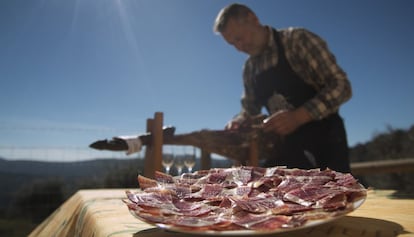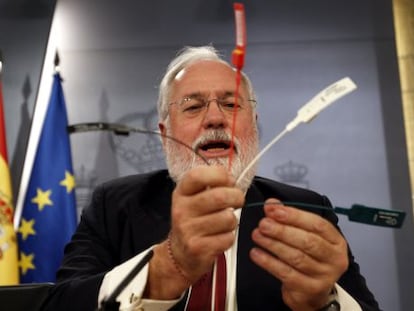The world¡¯s most expensive ham is from Huelva and costs €4,100 a leg
Eduardo Donato¡¯s Dehesa Malad¨²a brand has just been awarded a food product Oscar


Coming in at a hefty €4,100 a leg and hailing from Huelva province in southwest Spain, Dehesa Malad¨²a is already the world¡¯s most expensive ham.
And now its reputation has been sealed after it was recently awarded the charcuterie world¡¯s equivalent of an Oscar.
Held each February in Nuremberg, Biofach is Europe¡¯s leading organic foods trade fair and this year declared this unique dry-cured ham from Spain its best product.
Donat produces just 80 hams a year, and says the secret of his success is ¡°patience, passion, and pleasure¡±
The prize-winning ham comes from a rare breed of pig called the Manchado de Jabugo, which takes its name from the distinctive dark patches on the animals¡¯ coats. Dehesa Malad¨²a¡¯s founder, Eduardo Donato, helped rescue the breed from extinction a quarter of a century ago when he moved to the tiny community of Cortegana, in southwestern Spain¡¯s Huelva province.
Donato, aged 67, produces just 80 hams a year, and says the secret of his success is ¡°patience, passion, and pleasure.¡±
The Manchado de Jabugo breed has been kept alive over the years by a handful of dedicated farmers like Donato, but unlike him, most of them did not sell their produce, instead focusing on other types of pigs bearing the Huelva Denomination of Origin, of which there are now around 22,500.
Manchado de Jabugo ham¡¯s unique taste comes from the fact that the pigs eat only natural ingredients. Donato allows them to forage for acorns, almonds and to root around in the rolling woodlands of Huelva, which is washed by Atlantic rains. Its excellence has already been established by C¨®rdoba¡¯s Nutritional Science and Food Technology Department, after it was subjected to a tasting by 10 experts, based on international norms. These measure the intensity of its color, which in the case of Manchado de Jabugo is dark and lustrous; its fat, which is white and soft; its aromatic intensity, which is deep with notes of toasted dried fruit and bread crust; and its overall flavor, which is a balance of sweet and salty.
Manchado de Jabugo ham not only tastes wonderful, but it¡¯s good for you as well
The Manchado de Jabugo breed was hit by the swine fever epidemic of 1958, and then fell out of favor with farmers because it takes longer to reach maturity and is less fertile than other strains. A Manchado de Jabugo pig takes up to three years to reach maturity, while other varieties can be sold when they are as young as 14 months. It then takes another six years before the ham is fully cured. To further complicate matters, Manchado de Jabugo pigs sometimes fail to produce the dark pigmentation in their trotters that has become one of the distinguishing features of Iberian ham (pata negra).
Unsurprisingly, Donato looks after his pigs like few other farmers, sometimes sitting among them while they bathe and drink amid the fast-running streams of the Sierra de Aracena and Picos de Aroche UNESCO biosphere reserve. Aside from traditional veterinary treatments, Donato¡¯s animals are also treated by a homoeopathist, who cures cuts and grazes with a mixture of extra virgin olive oil and ash from the holm oaks that populate the hills of Huelva. They are de-wormed and treated for parasites with a special recipe made from mint and sunflower seeds.
Donato came to the area in 1990 after selling the construction company he had founded in his native Tarragona, buying a farm in Malad¨²a, an abandoned village around eight kilometers from the village of Cortegana.
He says he began learning all he could about sustainable pig breeding and ham curing, creating a company that he registered with the Spanish Ecovalia organic products certification, which carries out up to six checks each year on the animals that roam freely over Donato¡¯s 80 hectares of woodland.
The hams are now sold throughout Europe and as far afield as Hong Kong
¡°Our commitment to protecting the environment means we can only produce a certain amount of ham,¡± says Donato.
He runs a virtually one-man operation, aided only by his daughter Marta, who moved to the area six years ago, and a neighbor, who also helps out from time to time. His hams are now sold throughout Europe and as far afield as Hong Kong.
His customers are happy to pay top dollar, knowing they are acquiring a unique product as well as helping to save a rare breed. What¡¯s more, Manchado de Jabugo ham not only tastes wonderful, but it¡¯s good for you as well, being rich in protein, vitamins B1 and B6 and healthy minerals. High in unsaturated fatty acids, a 100 gram portion (which would cost around €50) provides around 185 calories.
Given the relative scarcity of top-quality Iberian ham such as Malad¨²a, along with the high cost of producing it, it¡¯s little wonder that some unscrupulous producers outside Spain have begun producing pata negra-¡°style¡± ham from animals that will have been factory fed and artificially fattened.
Tu suscripci¨®n se est¨¢ usando en otro dispositivo
?Quieres a?adir otro usuario a tu suscripci¨®n?
Si contin¨²as leyendo en este dispositivo, no se podr¨¢ leer en el otro.
FlechaTu suscripci¨®n se est¨¢ usando en otro dispositivo y solo puedes acceder a EL PA?S desde un dispositivo a la vez.
Si quieres compartir tu cuenta, cambia tu suscripci¨®n a la modalidad Premium, as¨ª podr¨¢s a?adir otro usuario. Cada uno acceder¨¢ con su propia cuenta de email, lo que os permitir¨¢ personalizar vuestra experiencia en EL PA?S.
?Tienes una suscripci¨®n de empresa? Accede aqu¨ª para contratar m¨¢s cuentas.
En el caso de no saber qui¨¦n est¨¢ usando tu cuenta, te recomendamos cambiar tu contrase?a aqu¨ª.
Si decides continuar compartiendo tu cuenta, este mensaje se mostrar¨¢ en tu dispositivo y en el de la otra persona que est¨¢ usando tu cuenta de forma indefinida, afectando a tu experiencia de lectura. Puedes consultar aqu¨ª los t¨¦rminos y condiciones de la suscripci¨®n digital.










































